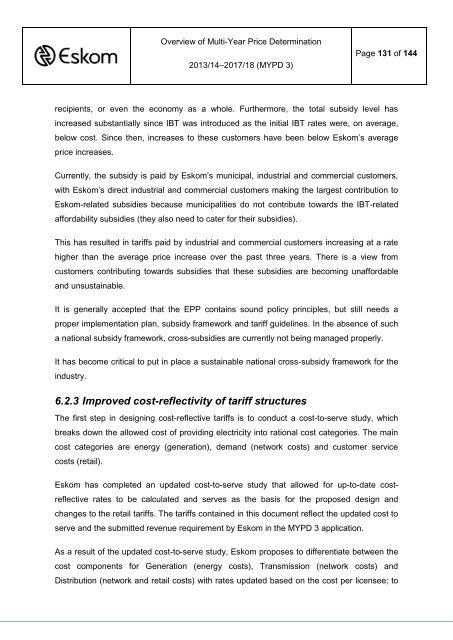Part 1 Revenue Application: Multi-Year Price Determination ... - Eskom
Part 1 Revenue Application: Multi-Year Price Determination ... - Eskom
Part 1 Revenue Application: Multi-Year Price Determination ... - Eskom
You also want an ePaper? Increase the reach of your titles
YUMPU automatically turns print PDFs into web optimized ePapers that Google loves.
Overview of <strong>Multi</strong>-<strong>Year</strong> <strong>Price</strong> <strong>Determination</strong><br />
2013/14–2017/18 (MYPD 3)<br />
Page 131 of 144<br />
recipients, or even the economy as a whole. Furthermore, the total subsidy level has<br />
increased substantially since IBT was introduced as the initial IBT rates were, on average,<br />
below cost. Since then, increases to these customers have been below <strong>Eskom</strong>‟s average<br />
price increases.<br />
Currently, the subsidy is paid by <strong>Eskom</strong>‟s municipal, industrial and commercial customers,<br />
with <strong>Eskom</strong>‟s direct industrial and commercial customers making the largest contribution to<br />
<strong>Eskom</strong>-related subsidies because municipalities do not contribute towards the IBT-related<br />
affordability subsidies (they also need to cater for their subsidies).<br />
This has resulted in tariffs paid by industrial and commercial customers increasing at a rate<br />
higher than the average price increase over the past three years. There is a view from<br />
customers contributing towards subsidies that these subsidies are becoming unaffordable<br />
and unsustainable.<br />
It is generally accepted that the EPP contains sound policy principles, but still needs a<br />
proper implementation plan, subsidy framework and tariff guidelines. In the absence of such<br />
a national subsidy framework, cross-subsidies are currently not being managed properly.<br />
It has become critical to put in place a sustainable national cross-subsidy framework for the<br />
industry.<br />
6.2.3 Improved cost-reflectivity of tariff structures<br />
The first step in designing cost-reflective tariffs is to conduct a cost-to-serve study, which<br />
breaks down the allowed cost of providing electricity into rational cost categories. The main<br />
cost categories are energy (generation), demand (network costs) and customer service<br />
costs (retail).<br />
<strong>Eskom</strong> has completed an updated cost-to-serve study that allowed for up-to-date cost-<br />
reflective rates to be calculated and serves as the basis for the proposed design and<br />
changes to the retail tariffs. The tariffs contained in this document reflect the updated cost to<br />
serve and the submitted revenue requirement by <strong>Eskom</strong> in the MYPD 3 application.<br />
As a result of the updated cost-to-serve study, <strong>Eskom</strong> proposes to differentiate between the<br />
cost components for Generation (energy costs), Transmission (network costs) and<br />
Distribution (network and retail costs) with rates updated based on the cost per licensee; to

















